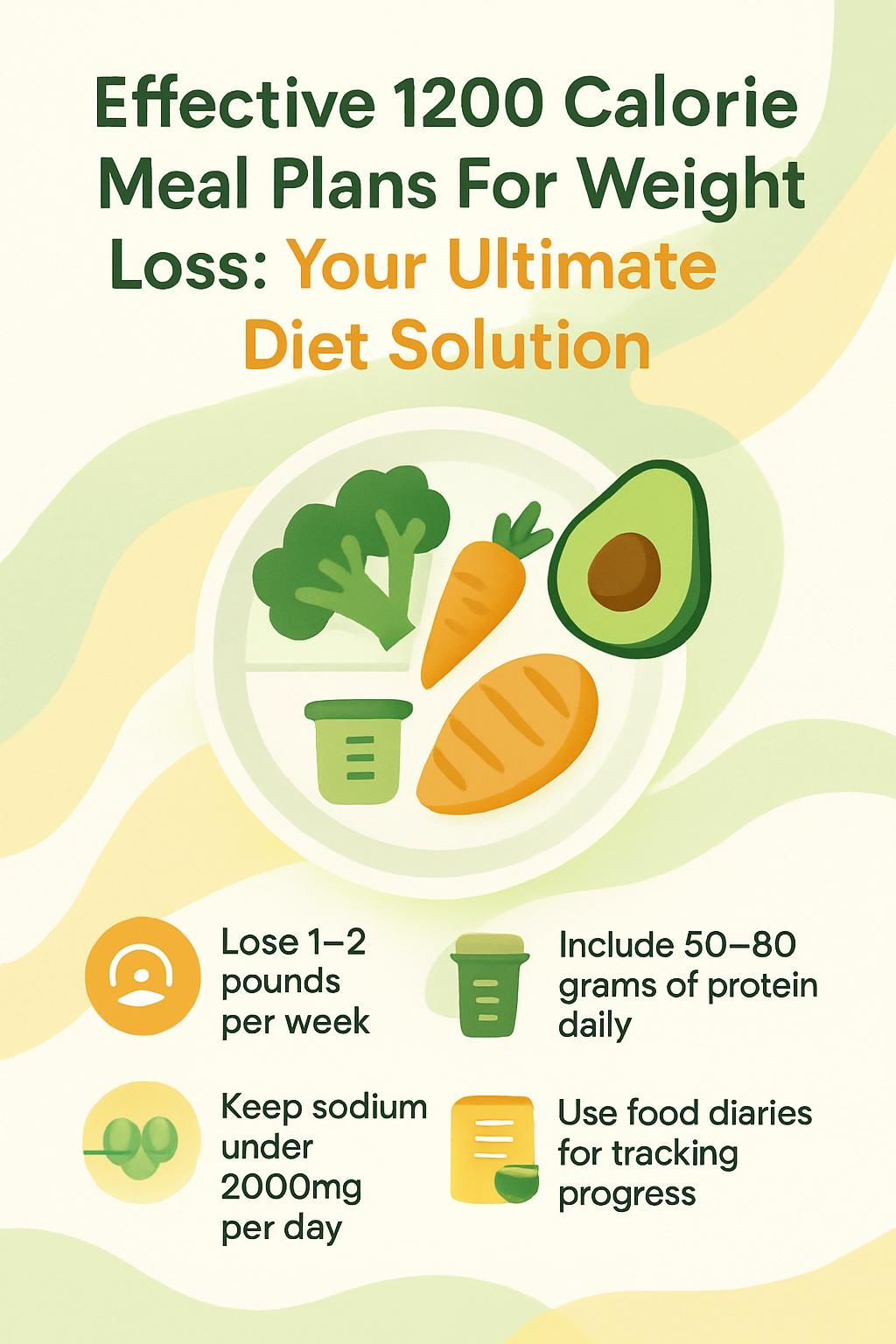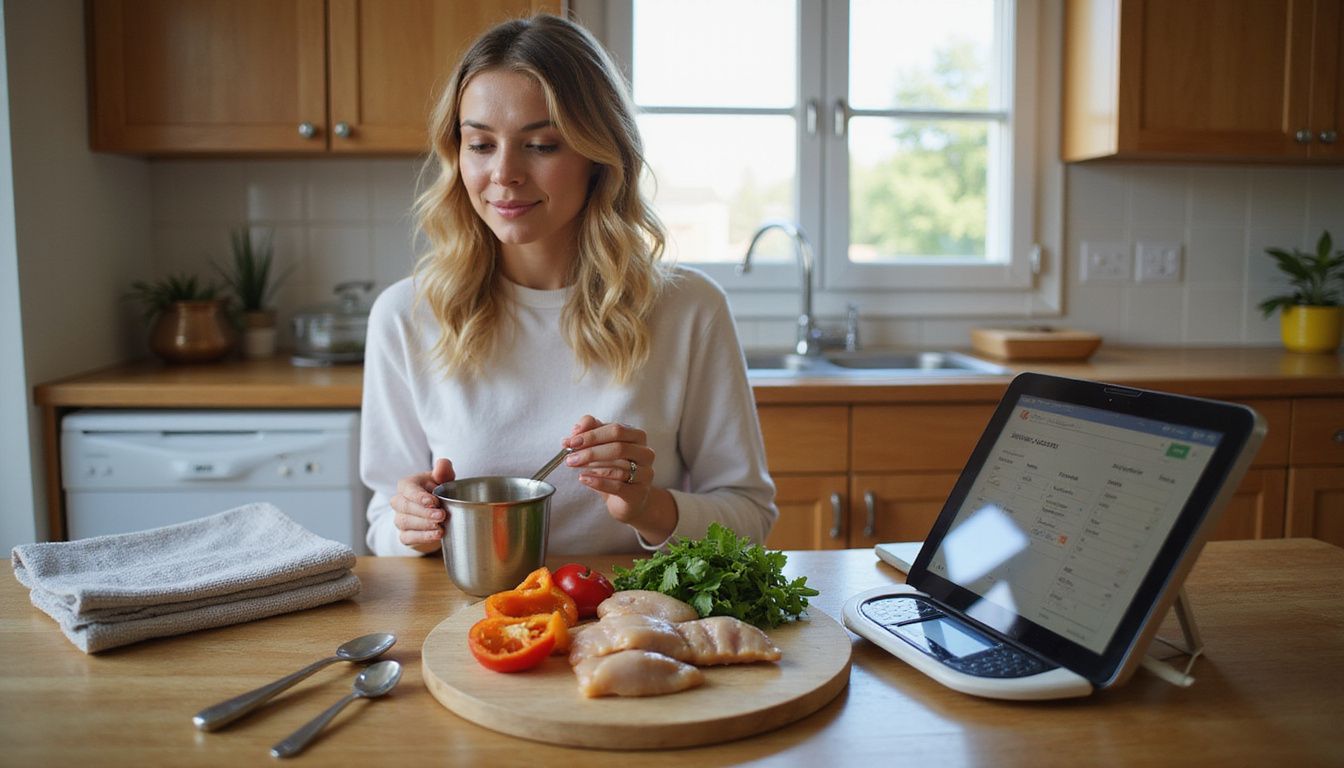Effective 1200 Calorie Meal Plans For Weight Loss: Your Ultimate Diet Solution
Our Nutrition Assistant AI Suite will transform your body. You will lose fat, get toned, and build muscle. Gain confidence and optimal health.
If you struggle to lose weight and track calories, you are not alone. A structured 1200 calorie meal plan can create a safe calorie deficit and still cover key nutrients. Research summaries from groups like the National Heart, Lung, and Blood Institute show steady loss of about 1 to 2 pounds per week is realistic with portion control and activity.
In this guide, you will see how to build a weekly menu, pick healthy foods, and use quick recipes. You will also learn simple prep skills that help you stay consistent during busy weeks.
Key Takeaways
- A 1200 calorie meal plan can support about 1 to 2 pounds of weight loss per week while meeting basic nutrient needs.
- Plan for at least 50 to 80 grams of protein daily, plus fiber from vegetables, beans, fruits, and whole grains for fullness.
- Portion control with a food scale and pre-portioned containers helps maintain a safe calorie deficit and keeps sodium under 2,000 milligrams.
- Check with your healthcare provider first if you have diabetes, heart disease, or other conditions, since needs vary by BMI and health status.
- Tracking meals in a diary aligns with the NHLBI Aim for a Healthy Weight guidance and supports long-term heart health.

What Is a 1200 Calorie Meal Plan for Weight Loss?

A 1200 calorie meal plan limits your daily intake to about 1,200 calories. This target creates a calorie deficit, the gap between calories eaten and calories burned. The goal is steady, sustainable weight loss without extreme hunger or missing nutrients.
Your menu centers on lean protein, high fiber produce, beans, and whole grains. Healthy fats like olive oil and avocado are included in small amounts for taste and vitamin absorption. You avoid ultra-processed foods and high sugar desserts.
A simple calorie calculator can help you count breakfast, lunch, dinner, and snack portions. Many people rely on nutrition software to confirm totals. Databases such as ESHA Food Processor can check protein, fiber, fats, and sodium so the plan fits health goals like stable blood sugar.
During a hectic month, I kept cooked brown rice and frozen riced cauliflower on hand. That one step made quick, low-calorie dinners much easier.
Key Benefits of a 1200 Calorie Meal Plan
A 1200 calorie diet can support weight loss and help manage conditions like high blood pressure or type 2 diabetes. It encourages balanced meals, steady energy, and clear portion limits.
How Does a 1200 Calorie Plan Help You Lose Weight Gradually?
Eating about 1,200 calories a day creates a calorie deficit, so your body uses stored fat for energy. Most people can expect 1 to 2 pounds of loss per week with consistent eating and activity.
Losing 5 to 10 percent of your starting weight over six months is a common medical target. Even 3 to 5 percent can improve blood pressure and glucose for people with diabetes.
Daily protein in the range of 50 to 80 grams supports muscle while you lose fat. Pair protein with fiber-rich vegetables and whole grains. Fiber slows the rise in blood sugar after a meal, which helps control hunger.
In my own plan, logging calories made progress visible without giving up foods I enjoy, like berry salads and yogurt. As weight dropped, my LDL cholesterol, the “bad” type, went down while HDL, the “good” type, improved.
Why Is Portion Control Important on a 1200 Calorie Diet?
Portion control keeps each meal within your calorie budget. Measuring ingredients and using meal prep containers helps prevent accidental overeating.
Weighing or measuring servings makes room for a wider mix of fruits, vegetables, whole grains, and lean proteins. As a simple guide, aim for about 3 to 4 ounces of cooked protein at meals, like a deck-of-cards size piece of chicken or fish.
Batch cooking in pre-portioned containers also reduces guesswork. A food scale, measuring cups, and a calorie calculator can tighten accuracy. Tracking waist size, along with weight, offers another clear view of progress.
What Are Nutrient-Dense Foods to Include?
Nutrient-dense foods pack vitamins, minerals, protein, and fiber into fewer calories. Build most meals from these picks:
- Vegetables: leafy greens, broccoli, spinach, tomatoes, cucumber, and colorful peppers.
- Whole grains: brown rice, oats, barley, and quinoa for steady energy.
- Lean proteins: Greek yogurt, turkey, chicken breast, tuna, chickpeas, and edamame.
- Healthy fats: avocado, nuts, seeds, and olive oil in small portions.
- Fruits: oranges, berries, grapes, plums, and apples for fiber and antioxidants.
- Low-sugar flavor: spices, herbs, citrus, and light sauces instead of heavy dressings.
Using these foods makes it easier to personalize meals, including vegetarian or vegan options.
How Can This Diet Improve Overall Wellness?
Eating balanced meals with enough protein and fiber can improve blood pressure, cholesterol numbers, and blood sugar. Even small losses of 3 to 5 percent of body weight can lower triglycerides and insulin, which supports heart and metabolic health.
Pair your food plan with regular activity and enough water. Simple routines like weekly meal prep reduce stress and save time. I noticed better sleep once I started measuring portions and swapped candy for fruit at lunch.
Preparing for a 1200 Calorie Diet
Good preparation sets you up for success. Check your health status, confirm nutrition targets, and match your calorie level to your activity.
Why Consult Healthcare Professionals Before Starting?
Healthcare providers help you decide if a 1,200-calorie plan suits your health. People with diabetes, heart disease, or other conditions may need a different calorie level or meal pattern.
Your provider can review BMI, a height-to-weight screening tool, and other measures like waist size. A registered dietitian can set protein and fiber goals and suggest changes that fit your daily schedule.
When I started, a quick visit with my doctor led to small adjustments in calories and exercise. Those changes matched my routine and made the plan easier to follow.
How to Check Nutritional Adequacy of Your Diet?
Use nutrition analysis tools to verify your plan. Software like the ESHA Food Processor can show calories, protein, carbs, fats, fiber, and sodium for each day.
A useful target is 50 to 80 grams of protein and around 30 grams of fiber per day. Many people also keep sodium under 2,000 milligrams. A food scale and an app reduce guesswork and keep totals on track.
Once the basics are set, review your activity level so your calorie target matches your energy needs.
How to Assess Your Personal Activity Levels?
Track how much you move each day with a step counter or simple log. Note whether most hours are spent sitting, walking, or doing physical tasks.
BMI can show weight risk for height, though it does not measure body fat directly. Waist size is another useful marker because it reflects changes in abdominal fat.
If you are very active, you may need 1,300 to 1,800 calories instead of 1,200. Last year, adding two power walks a week meant I needed one extra snack, like fruit and yogurt, to keep energy steady. Ask your healthcare team for guidance before changing your calorie level.
Crafting Your 1200 Calorie Meal Plan
Build each plate with protein, fiber-rich carbs, and healthy fats. This mix supports fullness, energy, and nutrition.
How to Balance Proteins, Carbohydrates, and Fats?
- Aim for 50 to 80 grams of protein daily to support muscle and curb hunger.
- Use whole grains such as brown rice, oats, and quinoa instead of refined grains.
- Plan around 130 to 140 grams of carbohydrates, focusing on vegetables, fruit, legumes, and oats.
- Keep fats near 50 to 60 grams, choosing olive oil, nuts, and seeds while limiting fried foods.
- Typical macro split: protein 20 to 30 percent, carbs 45 to 55 percent, fats 20 to 35 percent.
- Use a nutrition tool to review each recipe. Many sample days fall near 66 grams of protein and 53 to 57 grams of fat.
- Pair lean proteins with complex carbs at meals to steady blood sugar.
- Add a little healthy fat to help absorb vitamins A, D, E, and K.
- Adjust portions to match your activity while meeting your daily nutrient needs.
- Limit highly processed foods and keep sodium under 2,000 milligrams.
- Rotate proteins, for example Greek yogurt at breakfast, chicken at lunch, and turkey or tofu at dinner.
How to Incorporate Fresh Fruits and Vegetables?
- At breakfast, add a banana to bran flakes or fold spinach into scrambled eggs.
- Serve vegetable soups like tomato or butternut squash at lunch or dinner.
- Build salads with leafy greens, tomatoes, and broccoli for filling fiber.
- Snack on oranges, plums, or raspberries for natural sweetness and vitamin C.
- Use leftover produce in dishes like mushroom quesadillas to reduce waste.
- Buy seasonal items for better flavor and price.
- Reuse staples like tomatoes or spinach in omelets, salads, and grain bowls.
- Choose whole fruit over juice to keep more fiber.
- Roast extra vegetables during meal prep and store for quick add-ins.
A wide mix of produce helps you meet fiber goals and stay satisfied.
What Are the Best Whole Grains and Lean Proteins?
- Pick whole wheat pita at lunch for extra fiber and fullness.
- Use quinoa or couscous in dinner recipes for minerals and steady energy.
- Select lean turkey or Greek yogurt for concentrated protein with fewer calories.
- Choose flounder or pork tenderloin for lean dinner options.
- Add plant proteins like veggie burgers or edamame to support vegetarian meals.
- Make salads with chicken breast or tuna packed in water for simple lunches.
- Start some days with a whole grain English muffin to boost fiber early.
- Include lean proteins and whole grains at every meal to manage hunger and portions.
Switching from white bread to whole wheat pita made me feel fuller between meals, which helped me stick to my calorie target.
Which Processed and Sugary Foods Should Be Avoided?
- Skip sugary drinks like soda and sports beverages that add calories without nutrients.
- Avoid candy bars, packaged cookies, and pastries high in added sugar and unhealthy fats.
- Limit ice cream treats to rare occasions to control sugar intake.
- Replace high-sugar cereals with options like bran flakes or plain oats.
- Swap refined grains for whole grains to improve fiber and satiety.
- Pass on fried foods like French fries or fried chicken to reduce unhealthy fats.
- Reduce processed snacks such as chips and cheese-flavored crackers.
- Choose plain yogurt and add fruit instead of buying sweetened varieties.
- Be cautious with frozen meals that come with creamy sauces or high sodium.
- Air-pop popcorn instead of using microwave bags with salty flavorings.
Simple swaps make your plan more nutritious and easier to maintain.
A Week of 1200 Calorie Meals
Here is a one-week framework. It shows how to mix meals for balance and variety without guesswork.
What Does Day 1’s Balanced Meals and Snacks Look Like?
- Breakfast: 3/4 cup bran flakes with 1 banana and 1 cup fat-free milk.
- Morning snack: part-skim mozzarella string cheese.
- Lunch: mini whole wheat pita with 3 ounces turkey breast, roasted pepper, lettuce, 1 teaspoon mayonnaise, and mustard, plus two kiwis.
- Afternoon snack: fresh-cut vegetables or fruit if needed, while staying within calories.
- Dinner: grilled chicken or fish with mixed greens dressed with olive oil and vinegar, plus tomatoes or carrots.
- Hydration: water throughout the day.
Total for Day 1: about 1,229 calories, 58 g protein, 126 g carbs, 30 g fiber, 59 g fat, and 1,709 mg sodium.
What Does Day 2’s Balanced Meals and Snacks Look Like?
- Breakfast: smoothie with 1 cup frozen berries, half a banana, and 8 ounces low or fat-free milk, plus 1 to 2 hard-boiled eggs.
- Lunch: 1 cup vegetable soup and a veggie burger on whole-grain toast or a whole wheat English muffin, plus 1 cup grapes.
- Snack: 10 baby carrots with 4 tablespoons hummus.
- Dinner: 3 ounces grilled chicken breast or tofu with 1 cup steamed broccoli and 1/2 cup cooked brown rice.
- Evening snack: 5 walnut halves and 1 small apple.
- Hydration: at least eight cups of water.
- Total for Day 2: about 1,225 calories, 41 g protein, 181 g carbs, 36 g fiber, 41 g fat, and 1,842 mg sodium.
What Does Day 3’s Balanced Meals and Snacks Look Like?
- Breakfast: oatmeal for long-lasting energy and fiber.
- Lunch: chicken salad with vegetables for a protein-rich meal.
- Snack: low-fat yogurt or fruit for vitamins and calcium.
- Dinner: steamed shrimp, baked potato with salsa, sautéed spinach, and yogurt.
- Dessert: a small chocolate or ice cream bar within your calorie limit.
- Totals for Day 3: about 1,208 calories, 54 g protein, 146 g carbs, 31 g fiber, 52 g fat, and around 1,715 mg sodium.
- Planning ahead helps avoid extra snacks or processed foods.
What Does Day 4’s Balanced Meals and Snacks Look Like?
- Breakfast: Greek yogurt with fresh berries for protein and antioxidants, under 200 calories.
- Snack: carrot sticks or an apple to add fiber.
- Lunch: tomato soup with a whole wheat turkey and spinach sandwich.
- Snack: low-fat cottage cheese or berries to move toward 30 grams of fiber.
- Dinner: poached salmon with tangy cabbage slaw and 1/2 cup cooked quinoa.
- Close the day with unsweetened herbal tea for hydration.
These choices keep you within the 1,200-calorie range while providing omega-3 fats and whole grains.
What Does Day 5’s Balanced Meals and Snacks Look Like?
- Breakfast: Cheerios with fresh berries and sliced almonds.
- Snack: Greek yogurt with apple slices.
- Lunch: mushroom quesadillas on whole wheat tortillas with low-fat cheese.
- Snack: carrot sticks with hummus.
- Dinner: balsamic-glazed pork tenderloin with roasted butternut squash.
- Drinks: water or unsweetened herbal tea to control sodium.
- Totals for Day 5: about 1,220 calories, 55 g protein, 129 g carbs, 30 g fiber, 60 g fat, and roughly 1,803 mg sodium.
I tested this setup during a busy week. Prepping lunches in advance kept me on target.
What Does Day 6’s Balanced Meals and Snacks Look Like?
- Breakfast: one whole-grain waffle with 1 tablespoon nut butter and half a banana.
- Snack: an apple or similar fruit for fiber and hydration.
- Lunch: tuna salad made with light mayo or Greek yogurt, celery, greens, and tomato.
- Snack: eight baby carrots with two tablespoons hummus.
- Dinner: spicy sausage jambalaya with brown rice, lean chicken sausage, bell peppers, onions, and tomatoes.
- Sautéed spinach in a little olive oil on the side.
- Totals for Day 6: about 1,206 calories, near 80 g protein, 115 g carbs with 30 g fiber, 49 g fat, and around 1,306 mg sodium.
- Drink water instead of sugary beverages to avoid empty calories.
- Each meal highlights protein, fiber, and lower sodium choices.
What Does Day 7’s Balanced Meals and Snacks Look Like?
- Breakfast: English muffin with reduced-fat cheese, tomato, spinach, and a poached egg, plus half a grapefruit.
- Lunch: black bean salad with tomatoes, onions, cilantro, and lime juice, served with a small whole wheat tortilla.
- Snacks: low-fat or Greek yogurt with berries or sliced fruit, kept to single servings.
- Dinner: grilled chicken breast or baked fish with 1/2 cup quinoa or brown rice and steamed broccoli or sautéed spinach.
- Skip chips, packaged snacks, and sugary sodas to stay near 1,200 calories.
- Measure portions with kitchen tools for accurate servings.
- Use leftovers from earlier days to save time and reduce waste.
Writing meals in a notebook helped me stay precise with portions all week.
Tips for Effective Meal Prep
Meal prep cuts stress and supports your plan. A small amount of work on one day can simplify every other day.
How to Schedule Your Meal Planning Efficiently?
- Set aside one hour each Sunday to plan all meals and snacks for the week.
- Make a shopping list from the plan to avoid impulse buys.
- Cook a large pot of vegetable soup on Day 1 and freeze extra portions.
- Prepare blueberry banana overnight oats for grab-and-go breakfasts.
- Bake muffin-tin quiches midweek and freeze extras.
- Roast or bake a sheet pan of chicken thighs for easy add-ins to wraps or bowls.
- Label containers with the dish name and date before storing.
- Time grocery trips around sales on produce, lean proteins, and whole grains.
- Set phone reminders for key prep tasks to build consistency.
- Portion meals into single servings to match your 1200 calorie plan.
What Are Portion Control Techniques to Use?
- Use a food scale or measuring cups for each serving.
- Choose divided meal prep containers to separate mains and sides.
- Store single portions after batch cooking to reduce overeating.
- Pre-portion snacks like nuts or fruit in small bags or boxes.
- Measure servings for grains, proteins, vegetables, and oils.
- Use visual cues when measuring is not possible, like a palm-sized protein or half a plate of vegetables.
- Turn leftovers into new single-serve meals for the next day.
- Read labels to confirm serving sizes and calories.
How to Use Batch Cooking for Convenience?
- Make a big batch of vegetable soup and freeze individual servings.
- Cook chicken thighs on Sunday for use in salads, wraps, and rice bowls.
- Prepare muffin-tin quiches with eggs and vegetables for fast breakfasts.
- Cook extra brown rice or a second soup and freeze portions.
- Store roasted vegetables, proteins, and grains separately to mix and match.
- Plan meals that reuse components, like Monday’s chicken in Wednesday’s salad.
- Freeze extra rice or soup soon after cooking to lock in quality.
- Having batch-cooked items on hand helped me skip takeout during stressful weeks.
How to Store Meals to Keep Them Fresh?
- Refrigerate cooked meals in airtight containers within two hours of cooking.
- Freeze extra servings you will not eat within three days and date the containers.
- Keep muffin-tin quiches in the fridge up to three days or freeze for a month.
- Store grains and chopped vegetables separately to protect texture and flavor.
- Use microwave-safe containers for quick reheating on busy days.
- Pre-portion snacks and refrigerate if needed.
- Consider each item’s shelf life, since produce often spoils faster than grains or proteins.
Recommended Foods for a 1200 Calorie Diet
Choosing nutrient-rich foods makes a 1200 calorie plan easier to follow and more satisfying.
What Fresh Produce Should You Include?
Stock bananas, berries, oranges, plums, grapes, broccoli, spinach, tomatoes, and butternut squash. Use citrus fruit or berries as snacks to raise vitamin C and fiber. Build salads with leafy greens for lunches and dinners, and use tomato or squash soups for low-calorie comfort.
Roasted peppers add flavor to dinners, and sautéed spinach pairs well with lean proteins. A simple citrus slaw can refresh sandwiches or tacos. Repeating the same produce across meals cuts cost and waste.
Which Lean Protein Sources Are Best?
Choose turkey for sandwiches on whole wheat pita for a filling lunch. Flounder or salmon at dinner offers lean protein and omega-3 fats that support heart health.
Greek yogurt works for breakfast or snacks because it is high in protein with less fat. Pork tenderloin and tuna are strong entrée choices. For plant-based meals, try bean or chickpea veggie burgers for protein and fiber.
Chicken thighs add variety and reheat well for quick salads. Eggs and part-skim mozzarella provide protein plus B12 and calcium. Rotate your protein picks to keep meals interesting and balanced.
What Whole Grain Options Should You Choose?
Pick whole wheat pita, toast, or English muffins for extra fiber. Choose bran flakes or Cheerios as lower-sugar cereals. Prepare overnight oats for an easy, filling breakfast.
Use brown rice and frozen riced cauliflower in dinner bowls. Swap white bread for whole grain English muffins. Include quinoa or couscous at dinner for steady energy. Corn tortillas fit well with black bean salads and add complex carbohydrates.
How to Incorporate Healthy Fats?
Drizzle extra-virgin olive oil over roasted vegetables or sautéed spinach. Add sliced almonds to cereal for crunch. Spread natural nut butter on a whole-grain waffle or mash avocado onto sandwiches for creamy texture.
Use small portions, like 1 tablespoon of olive oil or 2 tablespoons of chopped nuts. Healthy fats help you feel full and aid vitamin absorption. I stayed satisfied by swapping mayonnaise for avocado in lunch wraps.
Foods to Exclude from a 1200 Calorie Diet
Some foods make it harder to manage calories and hunger. Limiting them protects progress and health.
Why Limit Sugary Drinks and Snacks?
One can of soda can add more than 150 empty calories. Drinks like this push you over your goal without providing nutrients. Sweet snacks like cookies and candy often leave you hungry again because they lack fiber and protein.
Pick fruit and yogurt for snacks to keep sugar lower while adding vitamins and minerals. Swap sweet cereals for low-sugar choices at breakfast. Replacing soda with water or unsweetened tea helped me keep energy steady through the day.
Which Highly Processed Items Should You Avoid?
Limit packaged chips, cheese puffs, and ready-to-eat meals. Avoid frozen breaded meats that bring extra sodium and unhealthy fats. Choose homemade soups instead of many canned options that are heavy on salt and preservatives.
Skip premade desserts like pastries and candy bars. Minimize processed meats such as hot dogs. Switch to whole grain bread to boost fiber and satiety. Cooking more from scratch cut my cravings and reduced hidden sugars in my week.
Why Cut Out White Bread and Refined Grains?
White bread and other refined grains raise blood sugar quickly. This surge can trigger hunger soon after eating. Whole grains like brown rice, quinoa, and whole wheat bread digest more slowly and keep you full longer.
Try these options in place of refined grains to improve fullness and nutrient intake.
| Type | Fiber (g) | Sugar (g) | Satiety Level* |
|---|---|---|---|
| White Bread, 1 slice | 0.5 | 1.4 | Low |
| Whole Wheat Toast, 1 slice | 2 | 1 | High |
*Satiety describes how full you feel after eating.
Switching to whole grains helped my morning energy and reduced mid-morning cravings.
Why Stay Away from Fried Foods?
Fried foods are high in calories and unhealthy fats, including saturated and trans fats. These raise the risk for heart disease and type 2 diabetes. Frying often adds a lot of sodium, which can raise blood pressure.
Use baking, grilling, or steaming to keep nutrients and control calories. A 1,200-calorie plan works best with nutrient-dense foods instead of fried choices.
Staying Motivated with a 1200 Calorie Diet
Motivation grows with small wins and clear feedback. Simple tools, used daily, keep you on track.
How Can a Food Diary Help Monitor Progress?
A food diary helps you track calories and spot patterns. Writing down meals can reveal triggers, like late-night snacking on stressful days. Seeing trends makes it easier to plan fixes, such as a higher-protein afternoon snack.
Logging also shows whether you are hitting protein and fiber goals. I used a plain notebook and found mistakes early, which kept me from slipping off plan.
| Food Diary Benefit | How It Helps |
|---|---|
| Tracks Calories | Supports staying close to the 1,200 calorie limit |
| Reveals Patterns | Shows where habits break down and need attention |
| Increases Accountability | Daily entries encourage follow-through |
| Highlights Nutrient Intake | Confirms protein and fiber targets are met |
| Builds Self-Reflection | Supports mindful choices at the next meal |
Why Celebrate Your Dietary Achievements?
Celebrating small milestones boosts motivation and consistency. Choosing fruit over dessert or measuring portions all week are wins worth noting.
Positive feedback makes it easier to keep going. Pick non-food rewards, like a new water bottle or extra time for a hobby, to mark progress.
How to Focus on Hydration and Self-Care?
Drink at least 8 cups of water daily. Lower calorie intake can reduce water from food, so carry a bottle and sip often. Hydrating snacks like oranges or watermelon add fluid and fiber.
Schedule short self-care breaks for stretching, a walk, or mindfulness to manage stress. A quick journal entry can track mood and motivation. Self-care raises energy and helps you stick to your plan.
Conclusion
A 1200 calorie meal plan offers a clear path to steady weight loss and better health habits. You focus on portion control, protein, fiber, and whole foods while keeping calories a day in range. A simple diary and basic prep skills make the process easier, even on busy weeks.
This information is educational and not a substitute for medical advice. Speak with your healthcare provider before starting, especially if you have diabetes, heart disease, or other conditions. Guidance from credible sources, such as the NHLBI Aim for a Healthy Weight program, supports safe progress while you build confidence in your routine.
With patience and consistency, you can reach a healthy weight and maintain it with meals that fit your life.
FAQs
1. What is a 1200 calorie meal plan and how does it help with weight loss?
A 1200 calorie meal plan limits daily food intake to about 1200 calories, which can create a calorie deficit for many adults. This helps the body use stored fat for energy, leading to gradual weight loss when paired with balanced nutrition and physical activity. Studies show that low-calorie diets can be effective under medical supervision.
2. Are 1200 calorie meal plans safe for everyone?
Not all individuals should follow a 1200 calorie diet. Adults with high activity levels or certain health conditions may need more calories to meet their nutritional needs. Health experts recommend consulting a registered dietitian or healthcare provider before starting any restrictive eating pattern.
3. What foods are included in an effective 1200 calorie meal plan?
Effective plans focus on nutrient-rich foods such as lean meats, whole grains, fruits, vegetables, and healthy fats like olive oil or nuts. A typical day might include oatmeal at breakfast; grilled poultry salad at lunch; fruit snacks; steamed fish with brown rice and broccoli at dinner.
4. How do I stay full while following a low-calorie diet?
Choosing high-fiber foods like beans and leafy greens along with protein sources such as eggs or tofu can help increase satiety throughout the day without exceeding your caloric target. Drinking water before meals also supports fullness based on clinical research findings.
Summary: A well-designed 1200 calorie meal plan uses evidence-based strategies to support weight loss by focusing on portion control and nutrient-dense choices while considering individual health needs for safety and effectiveness.







